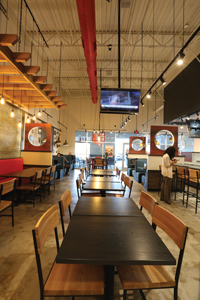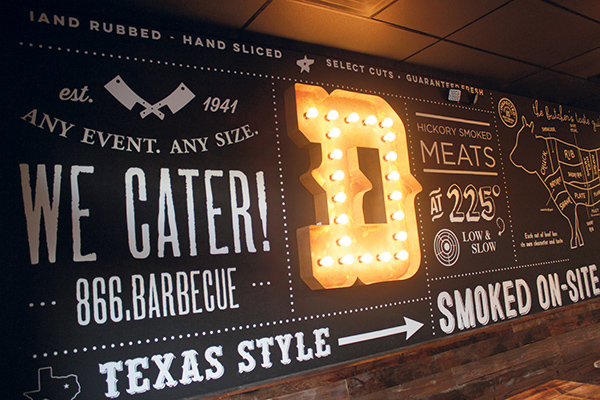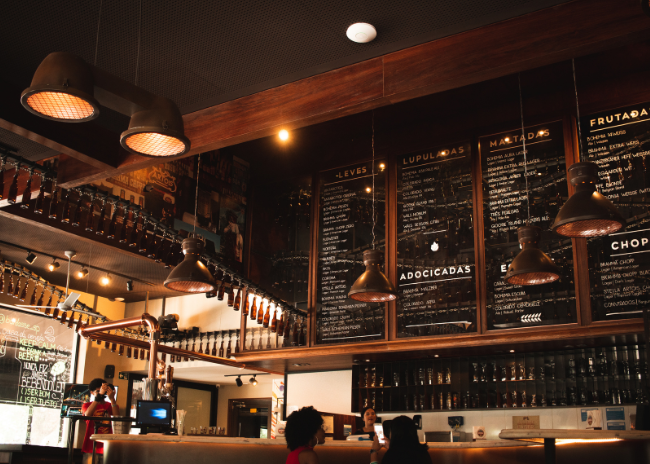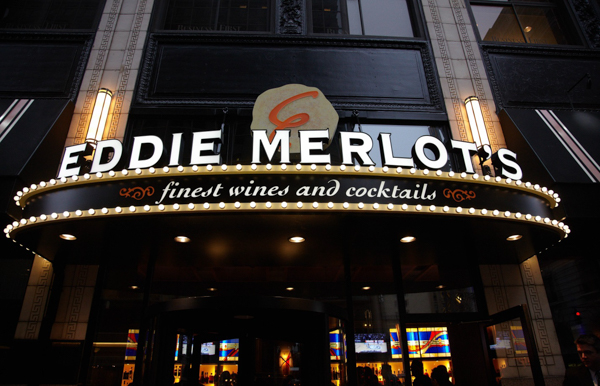One of the staples of fast-casual design could be described as the Subway or Chipotle model: Hot and cold pans behind a bio shield display all the options. Guests walk down the assembly line and pick out what they want on their burrito, sandwich, pizza, etc., then watch it get made before their very eyes.
With this design, customers get the exact meal they want while restaurants get to showcase their fresh ingredients. It adds a bit of theater and excitement to the guest experience.
 Bar-height seating, a new feature of the prototype, offers a space for solo diners, to-go customers and those who want to watch their pizza being made. Images courtesy of Clay Miller
Bar-height seating, a new feature of the prototype, offers a space for solo diners, to-go customers and those who want to watch their pizza being made. Images courtesy of Clay Miller
This is the approach Atlanta-based fast-casual pizza chain Uncle Maddio’s has taken since its start in 2009. That’s understandable: The chain, after all, was founded by Matt Andrew, former president of Moe’s Southwest Grill, which also uses the pick-your-ingredients approach. Recently, though, Uncle Maddio’s determined that this approach wasn’t the best fit for its operations.
According to Jenelle Brown, Uncle Maddio’s executive vice president in charge of operations and marketing, guests can choose from 45 different toppings — that’s far more than what you’ll find at a burrito place or sandwich shop.
While this approach to variety and customization encourages customers to try the concept, it creates a bottleneck in the queue. With so many choices, guests were taking too long to pick their toppings. A half minute of indecision times 15 people in line, for instance, would cause a massive slowdown.
This not only hurt the chain’s operations, but it also hampered the chain’s relationships with repeat customers, Brown says. “Our heavy consumers couldn’t really get in and out by design,” she explains. “You can only move as quickly as the person in front of you.”
Last November, then, Uncle Maddio’s rolled out a new prototype in Acworth, Ga., that reinvents the ordering and pizza assembly process. These changes led to the creation of entirely new sections in the restaurant and are accompanied by a redesigned dining area with updated furnishings, artwork and brand messaging.
New Ordering, New Flow
 Uncle Maddio’s features a new party table with funky retro custom wallpaper. Other custom wallpapers include Mediterranean travel themed at the to-go counter and the “served with love” wallpaper by the entrance.The linchpin of the new design is the chain’s remade ordering process.
Uncle Maddio’s features a new party table with funky retro custom wallpaper. Other custom wallpapers include Mediterranean travel themed at the to-go counter and the “served with love” wallpaper by the entrance.The linchpin of the new design is the chain’s remade ordering process.
In the chain’s previous prototype, guests queue then walk down the assembly line and place their order. Once a staff member created a pie and placed it in the oven, guests paid at a point of sale (POS) station at the end of the assembly line.
The new design shifts the POS stations ahead of the assembly line and pairs them with a set of electronic menu boards that rotate the different specialty pies, ingredients and limited-time offerings. Guests now walk in, pick what they want on their pizza based on the menu board, then order and pay. Since guests aren’t asked to pick their toppings from a display, the entire process is much quicker. This allows them to get their drinks, sit down and enjoy their experience sooner, says Jennifer Rotondo, who worked on the redesign as founder of Atlanta-based design firm The Kitch.
“If you go to a pizza restaurant that you sit down and dine in, you don’t get to pick your toppings” by looking at them, Rotondo says. “We’re kind of going back to the original model of building pizzas in a traditional restaurant.”
This change not only sped up the ordering process, but it also increased labor productivity, notes Brown. Now that pizza makers aren’t interacting with guests, the assembly line moves much more quickly, allowing the culinary team to cook more pies in a set amount of time.
Butterfly Effect in a Box
This shift in ordering was itself a major change, but it led to a number of other changes that impacted the way Uncle Maddio’s presents itself and how guests experience the restaurant.
According to Rotondo, while the earlier Uncle Maddio’s design was fun and inviting, there were some aspects of the brand that could have been better emphasized. These include the freshness and quality of the food and the restaurant’s “served with love” guarantee, which offers guests a refund and a replacement item if they’re not happy with their order. The new prototype emphasizes these aspects with a design Rotondo describes as “Mediterranean sophisticated with a hint of rustic industrial.”
The chain’s “served with love” guarantee is the first thing guests encounter when they walk into the chain’s stores with the new design. Just past the entryway is the “served with love” wall, which includes custom wallpaper of hands kneading dough, the “served with love” promise painted on a white brick image and the word “love” spelled out in red. A sign then directs them to the dine-in or takeout POS station.
The dine-in POS was not only relocated in the new prototype, but it also got a serious makeover, says Brown. In the previous design, the POS station was at the end of the ordering process, so it was designed with a very transactional appearance. With the POS now one of the first customer touchpoints, Uncle Maddio’s now has a retail aesthetic. Out is the stainless-steel counter — expensive and hard to work with, says Rotondo — and in is a solid-surface countertop. The space also features a grab-and-go cooler holding bottled drinks as well as a beer tap and wine bottle display. Once guests place their order here, they’re free to grab a drink and sit down.
Notably, though, they’re not required to. While Uncle Maddio’s shifted its ordering station, its assembly line is still in the front of the house. Guests are free to walk down the line as staff makes their pie and, thanks to the chain’s flat pricing for pizza, change their ingredients.
To make this work, however, the POS station isn’t exactly in line with the assembly line. Instead, it sits against it like an endcap. With this setup, guests who want to watch the culinary staff assemble their pizza do so away from the normal flow of traffic.
The pizza assembly area got some upgrades in the redesign, in an attempt to both spruce up its appearance and lower build-out costs. The face of the assembly line counter, for instance, was previously clad in subway tile. Uncle Maddio’s now uses laminate, which looks warmer and is less expensive.
In addition, a large red panel adorns the front of the hood, with the Uncle Maddio’s bottlecap-style logo sitting front and center. This helps provide some extra visual appeal to the kitchen and offsets a competitive advantage of other fast-casual pizza concepts, Brown says.
“One of the things that our competitors do well is they have these woodfire ovens,” Brown explains. “They put these logos inside of them, and people think they’re sexy and cool. Our oven is great for consistency. It works with a conveyor belt: The pizza goes in one side and out the other. But that means it’s not very attractive. That shell is actually designed to draw people’s attention away from the oven under the hood.”
Past the ordering line, at the back of the restaurant, sits the POS for to-go, online and third-party delivery orders. This station is new to Uncle Maddio’s. Like the directional sign at the entrance, it was added to emphasize that the chain does accommodate off-premise dining.
To drive the point home, the restaurant developed custom wallpaper for the space with a retro Italian travel scene — think vintage Fiats, gondolas and Vespas. The designers took the opportunity to include a freshness cue in this area as well: The wallpaper sits against a walk-in cooler. A wallpaper with a hole in it has been designed to show a window into the cooler, giving guests a view of fresh veggies, cheeses and other items.
 The new design moves the POS station before the assembly, speeding up the ordering and make process. As one of the first guest touchpoints, this area was designed with a retail look, not just as a transaction space.
The new design moves the POS station before the assembly, speeding up the ordering and make process. As one of the first guest touchpoints, this area was designed with a retail look, not just as a transaction space.
The to-go POS station, along with changing how customers place orders, led to the creation of another section in the prototype: a counter-height bar that faces the assembly line. Made of hardwood, the bar gives guests who want to enjoy the theater of pizza production a natural place to sit. It also serves as a place where people waiting for to-go orders can wait without feeling like they are in the way or out of place.
That isn’t the only new seating area in the dining room. Essentially, the restaurant’s entire seating package was remade in the prototype.
“Part of the feedback from the research that we did was that people really use the brand in a very flexible way,” says Brown. “They may come in with their family on a Friday night. They may come in for work meetings; they may come in by themselves. We really wanted people to be able to walk into the restaurant and find a place that they felt comfortable sitting.”
One of the highlights of this new seating package is the new party booth. Located in the back corner, this space is designed for fun, with a large starburst-shaped pendant light hanging overhead and custom wallpaper featuring several vintage/quirky illustrations depicting Mediterranean travel themes.
One thing taken away from this area, though, was a flat-screen that was previously mounted in the corner. With the wallpaper, a television would just make the space too visually crowded. In addition, Uncle Maddio’s found that too many televisions detracted from the experience it wants to provide to its guests. “The previous prototype had a number of flat-screens, making it a little too sports bar-y, so we wanted to take that out. We wanted to allow for conversation among groups,” says Rotondo.
Moving toward the front, the next seating area is a banquette upholstered in red vinyl — a brighter, more energetic shade of red than what the chain used previously. Porthole dividers that offset the sea-of-tables effect while not being disruptive help define this space. Overhead, meanwhile, is a wooden cloud element with hanging bulbs threaded between the slats. These lights replaced the prior design’s track lighting, which was more expensive, less flexible and didn’t illuminate as well, says Brown.
The front section of the restaurant includes new booths — no longer elevated, reducing build-out costs — along with a new community table. The location of the community table is notable, says Brown, since most restaurants locate this seating toward the back, away from other parties. “We really wanted to do the exact opposite,” she says. “We really wanted that to be a focus and create some energy around the center of the dining room.”
The community table’s lighting also draws the eye. In another industrial nod, a red cage the size of the table hangs overhead. This adds some visual flair for diners inside and passersby can see it, helping the restaurant get noticed, Rotondo says.
Future State
 Uncle Maddio’s cut $100,000 out of its build-out cost with this new design. Savings include an open ceiling instead of a dropped ceiling, stained concrete floors versus tile, and wooden chairs instead of upholstered.Since the opening of the first Uncle Maddio’s with the new design, there have been very few adjustments to the prototype, Brown says.
Uncle Maddio’s cut $100,000 out of its build-out cost with this new design. Savings include an open ceiling instead of a dropped ceiling, stained concrete floors versus tile, and wooden chairs instead of upholstered.Since the opening of the first Uncle Maddio’s with the new design, there have been very few adjustments to the prototype, Brown says.
One of the most significant ones, though, is more of a focus on operations than design. According to Brown, some guests still want to walk down the assembly line and pick their toppings. While the design allows for that, connecting these guests with their actual pizza (and not another person’s) along with the kitchen’s ticketing system has been clunky. The chain is developing strategies to smooth out this process.
Another adjustment was actually made before the new prototype was built. In May 2017, Uncle Maddio’s opened a store in Castle Rock, Colo., with the pay-first system but no decor changes. The chain placed three POS stations up front. That was simply too many, says Brown; during peak times, the kitchen couldn’t keep up with orders, and guests were waiting too long for their food. In the full prototype, the chain specified two POS stations for dine-in customers and one for to-go, smoothing out any throughput problems.
Other adjustments are being made not based on the design itself but on the type of growth Uncle Maddio’s projects. According to Brown, the chain sees nontraditional locations, such as airports and colleges, as a big part of its future. In Q3 of 2018, in fact, the chain expects to open a location at Hartsfield–Jackson Atlanta International Airport.
Design changes in the airport location will include adding a large neon “pizza” sign to the storefront to make the concept clear to travelers unfamiliar with the brand. This location will also offer kiosk ordering, which Uncle Maddio’s hopes will help move the line along more quickly. “The airport is a prime location where people are trying to get in and out. If the guest can order on a screen that has pictures and allows for you to select as you go, this could significantly impact speed of service in a very positive way. We’ll see how it does,” says Brown.
While this represents a significant operational change, it’s not a shift in the chain’s priorities. After all, the new prototype itself was developed with the primary goal of improving speed of service and therefore the overall customer experience.
“We led with the customer journey,” Brown says. “You can go get your soda, sit down with coworkers or family, and have your food at the table in eight minutes. You can enjoy your experience faster versus standing in line.”

Project Team
- Project lead: Jenelle Brown
- Architect: Tom Tedrow
- Kitchen supplier: Trimark
- Interior design: Jennifer Rotondo
Snapshot
- Headquarters: Atlanta
- Concept owner: Matt Andrew
- Concept: Pizza, calzones, salads, wings
- Segment: Fast casual
- Average check: $10
- Units: 35
- Opened: 2009
- Size: 2,600 square feet
- Real estate: Endcap, daily needs shopping center
- Design highlights: Order and pay up front, digital menu boards, emphasized to-go area, community and individual seating, decor update
- Build-out time: 8-10 weeks



